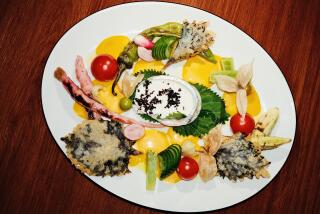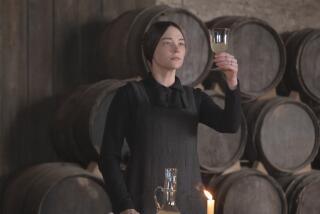New wines, ancient cellar
Jean-GUILLAUME Prats, the 35-year-old director-general of Cos d’Estournel, in the St.-Estephe region of Bordeaux, was in town not long ago, talking about his wines over lunch with a dozen local wine lovers.
“How’s the 2004 vintage?” one oenophile asked.
Prats smiled a tight smile and said nothing for a few seconds. Then:
“You can tell something from the fact that I’m not answering you right away.”
We all laughed.
“You mean that because you didn’t immediately say it’s fabulous, we should know it’s not?” I asked.
“Well,” Prats said, “it’s what we call a difficult vintage.”
The ’04 Cos will be the sixth since Prats took over from his father, Bruno Prats, shortly before the family sold the winery to the Bordeaux wine firm Bernard Taillan and a group of Argentine investors. That marked the sixth time the winery had changed hands since Cos wines were first vinified separately in 1811 by its founder, Louis Gaspard d’Estournel.
Cos d’Estournel is a second growth (deuxieme cru) chateau, and its wines are usually the best in St. Estephe -- especially over the last 20 years. In some vintages, it rivals the first growths. The 140-acre vineyard and chateau have quirky, pagoda-like towers that make the property a popular tourist destination.
Jean-Guillaume Prats stayed on to run the property after the sale to Taillan, and he has brought what he calls a “more meticulous approach” to the winemaking.
He was “strongly influenced” in this, he says, by “the garagistes of St. Emilion,” the small, independent winemakers whose wines have earned huge Robert Parker scores and concomitantly huge prices in recent years.
Historically, the wines of St. Estephe have been among the most tannic and slowest to mature in the Medoc. But Prats’ reliance on the softer Merlot and his use of the garagistes’ approach to both the vineyard and the winemaking process have made his wines more approachable earlier. He’s cut his yields per acre almost in half and implemented “green harvesting” -- having laborers remove leaves from the vines twice each summer to expose the grapes to more sun -- thus increasing the ripeness of the grapes (which he now picks later) and the concentration of the resultant wine. He also leaves the wines in barrels six months longer than his father did “so the wine will be silkier in texture,” he says.
I’ve always liked Cos -- only in part because I could sometimes afford to buy it -- but I’ve liked the wines even better since Jean-Guillaume took over from his father, even as prices have risen. His wines seem riper and richer but without losing their traditional elegance and their potential for aging.
“Will those garage wines and wines made like them age well?” one lunch guest asked.
“It’s impossible to tell yet,” Prats answered. “They’ve only been making them for about 10 years.”
Folks around the table -- we were at Lucques in West Hollywood -- were clearly delighted to have a Bordeaux principal in their midst, and they peppered Prats with questions.
This wasn’t a meeting of a regular tasting group, of which there are many in Los Angeles. It was just a casual group of wine lovers and collectors, many of them customers and/or acquaintances of Steve Wallace and Christian Navarro of Wally’s Wines and Spirits in West Los Angeles, who organized the event.
“What’s your own favorite of all the Cos d’Estournels?” one guest asked.
“The 1870,” Prats answered.
In some gatherings, this response would have been greeted with gasps of envy, disbelief or derision. But these were serious wine lovers, with serious bank accounts, and the man who asked the question immediately wrote down Prats’ answer in his notebook, clearly determined to search the auction and collectors’ markets for his own bottle of 1870 Cos d’Estournel right after dessert.
In fact, this fellow said, “I was hoping to bring a 1928 Cos to lunch today, but the guy I was going to buy it from was too far away for me to get it here in time.” (The ’28 is widely thought to be the best Cos d’Estournel in the chateau’s storied history.)
The only requirement for attendance at our lunch was that everyone had to bring a bottle (any bottle) of Cos -- I brought a 1996 -- and as we drank them with Suzanne Goin’s steak frites, conversation naturally turned to who liked which vintage best. Some voted for the 1966, some for the 1982, others (including me) for the 1986 or ’96.
The ’82 had a strong concentration of cassis and blackberry, quintessential Cabernet components, and there was an uncharacteristically smoky quality to the ’86 that made it -- dare I say this? -- the perfect French-fry wine. The ’96 wasn’t quite ready to drink yet, but its strong structure and coffee-like intensity made me wish I had another bottle to cellar for six or eight years.
Prats declined to pick a favorite -- “They’re all for sale,” he said, grinning -- but he was surprisingly candid about the decline of the 1985 and the 1990.
“They’re both starting to die,” he said. “Drink up.”
The ’85 is one of the few wines I’ve ever bought a full case of, and I’m happy to say I finished the last bottle several years ago -- when it was still excellent.
I asked Prats if he could have identified the vintage of each of his wines if he’d tasted them blind.
“Absolutely” -- pause, smile -- “not,” he said, in another surprising burst of candor.
Prats seemed atypically frank for someone tasting his own wines with sophisticated, well-heeled collectors who would likely share his comments with wine-collecting buddies -- none of whom would then be likely to rush out and buy ’85 or ’90 Cos d’Estournel at auction.
Because the 2004 was the most recent vintage, we returned to talk of its prospects several times, and Prats was happy to oblige.
“The Merlot was very good, better than 2003,” he said at one point, in response to a question. “But the Cabernet wasn’t as good. And it rained really hard on Oct. 11 and 12, so if you didn’t harvest before that, your vineyards were underwater, and you won’t be making great wine.”
Did Cos d’Estournel finish its harvest before the rains?
I’ve never met a winemaker anywhere in the world who didn’t answer “yes” to that question, whether that was the honest answer or not, and Prats wasn’t about to be the first.
“Yes,” he said.
He also said his winemakers had adjusted Cos d’Estournel’s traditional encepage of 60% Cabernet, 40% Merlot to 55% Merlot, 45% Cabernet for 2004 to reflect the relative qualities of the two grapes last year.
Because he’d been so candid on other matters, I was inclined to believe Prats about his 2004 harvest date. In fact, I found his general manner so refreshing that I mentioned it to Navarro, who said, “Well, he’s definitely one of the new breed of vignerons in Bordeaux, guys who are younger, part businessman, part artist, open to the New World and inclined to prefer truth to hype.”
Someone asked Prats what wines he likes to drink when he isn’t drinking his own.
Like most Bordelais, he doesn’t drink much Burgundy.
“But I like the wines of Spain very much -- especially Vega Sicilia. And I like the Sauvignon Blancs from New Zealand. And in California, I like Harlan Estate.” He paused. “What I really like -- this may surprise you -- is to drink Sauternes with oysters. The sweet and the salt make a really great combination.”
Reaction ranged from the startled “He’s got to be kidding” to the more widespread “Gee, I’ll have to try that.”
Inevitably, questions about Parker came up.
“Does Parker have too much power?”
“Some people in Bordeaux say so ... “ Prats said, shaking his head, “usually those who get low Parker scores. But I’ve found him to be the most charming, knowledgeable, hardworking and honest of all the critics. The power he has is the power he’s earned.”
Prats’ praise is not surprising, given Parker’s consistently high scores for Cos d’Estournel. But Prats is right about Parker’s strengths, and Parker is powerful precisely because of those strengths -- and because the people who make and, especially, those who sell wine have tried to exploit his power for their own advantage, often marketing wines with no more than a Parker score: “98 -- Parker.”
Parker gave the as yet unreleased 2003 Cos -- which Prats described as one of his personal favorites -- a preliminary rating of 95 to 98 and has called it “one of the greatest offerings this hallowed estate has ever produced ... substantial yet extraordinarily elegant.”
That wine should be available here early in 2006. Meanwhile, I see the 2001 in local stores. It, too, has done well with critics -- 93 points from Parker, 92 from Steve Tanzer -- and although it’s too young and tannic for me now, I like it better than the highly touted 2000.
Prats will return to Los Angeles in the spring for a luncheon and vertical tasting of many of the best vintages of Cos d’Estournel dating back to the early 1950s (and a few even older), according to Bipin Desai, a UC Riverside physicist who organizes many major wine tastings locally. The venue isn’t set yet, but the date is -- tentatively May 22.
I can’t wait. Tasting good wines with the man responsible for them and willing to talk about them honestly is a rare and delightful experience.
In fact, Prats seemed like such a straightforward and unassuming fellow at our lunch that if I didn’t think it would be rude and presumptuous, I’d e-mail him and ask if he could possibly bring along a bottle of his ’28.
David Shaw can be reached at david.shaw@latimes.com. To read previous Matters of Taste columns, please go to latimes.com/shaw-taste.
More to Read
Eat your way across L.A.
Get our weekly Tasting Notes newsletter for reviews, news and more.
You may occasionally receive promotional content from the Los Angeles Times.









